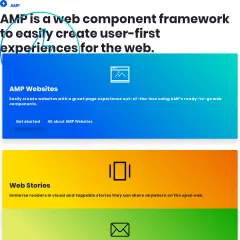AMP 
AMP is used by 0.30% of sites
Official Website
https://www.amp.devCategory
JavaScript Frameworks
AMP (Accelerated Mobile Pages) is an open-source project aimed at improving the performance and user experience of web pages on mobile devices. AMP focuses on delivering fast-loading and visually appealing content by using a restricted set of HTML, CSS, and JavaScript.
AMP provides its own JavaScript library called "AMP JS" that is designed to work specifically with AMP pages. The AMP JS library is responsible for managing and optimizing the loading of AMP content, including the handling of resources, lazy loading of images, and applying performance optimizations.
Here are some key features and capabilities of AMP JS:
Performance Optimization: The AMP JS library implements several performance optimizations to ensure fast page rendering and smooth user experience. It includes features like asynchronous loading of resources, pre-rendering of off-screen content, and prioritized rendering of visible content.
Resource Loading and Validation: AMP JS handles the loading and validation of resources within AMP pages. It enforces certain restrictions on HTML, CSS, and JavaScript to ensure optimal performance and security. The library also validates AMP pages against the AMP HTML specification to ensure compliance.
Lazy Loading: AMP JS supports lazy loading of images, videos, and other media elements. This means that only the content visible on the screen is loaded initially, and as the user scrolls, additional content is loaded dynamically. Lazy loading helps to improve page load times and reduces unnecessary resource downloads.
Third-Party Embeds: AMP JS provides components and built-in support for integrating third-party content and services, such as social media widgets, video players, analytics, and advertisements. These components are optimized for performance and follow AMP guidelines to ensure a smooth user experience.
Responsive Layouts: The library offers responsive layout features that automatically adapt the content to different screen sizes and devices. It helps ensure that the AMP pages are mobile-friendly and look great across various devices and orientations.
Caching and Preloading: AMP JS includes a built-in caching mechanism that allows AMP pages to be served from various content delivery networks (CDNs) and cached by browsers. This helps to further improve page load times and reduce server load. Additionally, AMP supports preloading of pages in the background to provide near-instantaneous navigation between AMP pages.
It's important to note that while AMP JS provides performance and optimization benefits, it also comes with certain limitations and restrictions due to its focus on speed and efficiency. The use of AMP is particularly beneficial for content-heavy and news-oriented websites where fast loading and improved mobile experience are essential.
If you're considering implementing AMP on your website, you can refer to the official AMP documentation and resources available on the AMP Project website for more details on how to create and optimize AMP pages using AMP JS.
AMP provides its own JavaScript library called "AMP JS" that is designed to work specifically with AMP pages. The AMP JS library is responsible for managing and optimizing the loading of AMP content, including the handling of resources, lazy loading of images, and applying performance optimizations.
Here are some key features and capabilities of AMP JS:
Performance Optimization: The AMP JS library implements several performance optimizations to ensure fast page rendering and smooth user experience. It includes features like asynchronous loading of resources, pre-rendering of off-screen content, and prioritized rendering of visible content.
Resource Loading and Validation: AMP JS handles the loading and validation of resources within AMP pages. It enforces certain restrictions on HTML, CSS, and JavaScript to ensure optimal performance and security. The library also validates AMP pages against the AMP HTML specification to ensure compliance.
Lazy Loading: AMP JS supports lazy loading of images, videos, and other media elements. This means that only the content visible on the screen is loaded initially, and as the user scrolls, additional content is loaded dynamically. Lazy loading helps to improve page load times and reduces unnecessary resource downloads.
Third-Party Embeds: AMP JS provides components and built-in support for integrating third-party content and services, such as social media widgets, video players, analytics, and advertisements. These components are optimized for performance and follow AMP guidelines to ensure a smooth user experience.
Responsive Layouts: The library offers responsive layout features that automatically adapt the content to different screen sizes and devices. It helps ensure that the AMP pages are mobile-friendly and look great across various devices and orientations.
Caching and Preloading: AMP JS includes a built-in caching mechanism that allows AMP pages to be served from various content delivery networks (CDNs) and cached by browsers. This helps to further improve page load times and reduce server load. Additionally, AMP supports preloading of pages in the background to provide near-instantaneous navigation between AMP pages.
It's important to note that while AMP JS provides performance and optimization benefits, it also comes with certain limitations and restrictions due to its focus on speed and efficiency. The use of AMP is particularly beneficial for content-heavy and news-oriented websites where fast loading and improved mobile experience are essential.
If you're considering implementing AMP on your website, you can refer to the official AMP documentation and resources available on the AMP Project website for more details on how to create and optimize AMP pages using AMP JS.